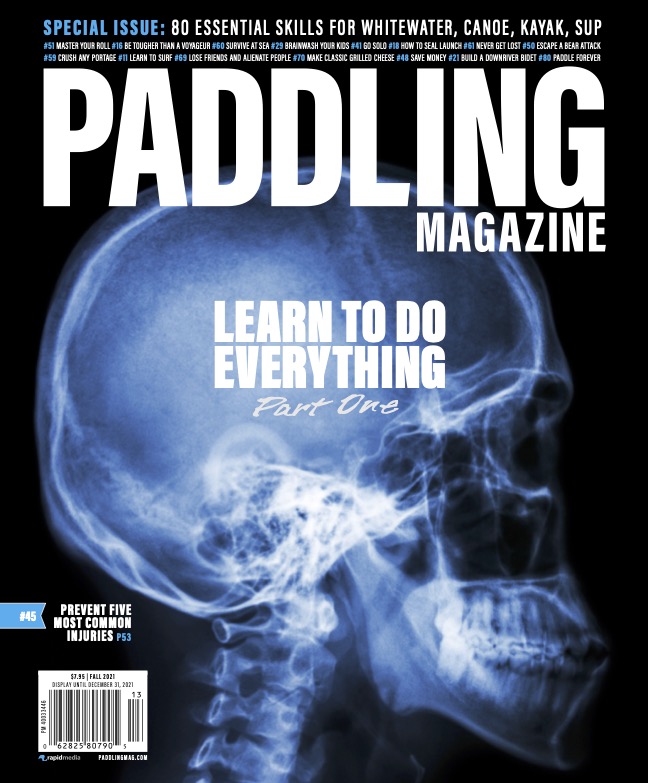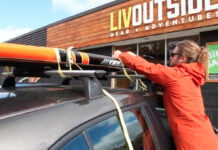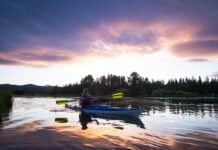Choosing to run whitewater, and doing it successfully, can be a highlight on your next canoe trip. Jumping in over your head, however, can ruin your trip or at least your gear. Often your choice and success comes down to your ability to read water—the language of rivers—and understand what it is trying to communicate to you. Here are the basics to help you learn how to read whitewater rapids.
Learning how to read whitewater
Being fluent in reading whitewater begins by learning to interpret its two main visual characteristics: texture and colour. When observing moving water, as it winds its way over rocks, ledges and around outcrops, you’ll witness a veritable kaleidoscope of changing colours and wave patterns.
Each obstacle leaves a visual marker to its presence. By looking at the river’s textures and colours you can decipher the characteristics of the riverbed, the difficulty of the water features and ultimately, make a choice as to whether you should run the rapid.
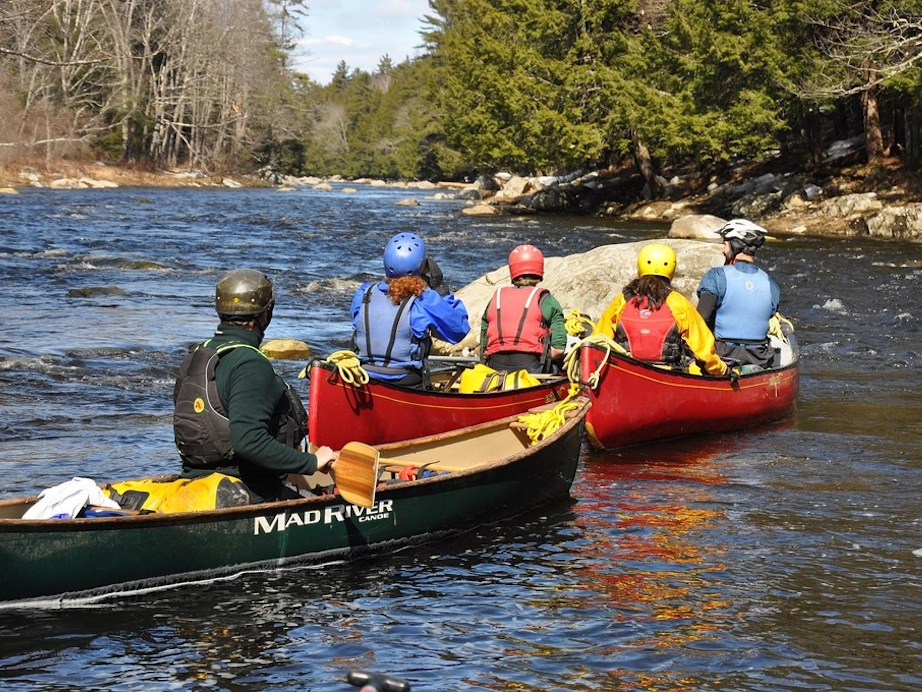
Whitewater signs to watch
For many, a rapid is first judged by the roller coaster of waves they’ll ride during the run. Beyond looking at size, navigable waves usually occur in groups or families called standing waves. Standing waves are dark in colour, often with crashing white tops and usually have three or more similar, evenly spaced waves decreasing in size as you look downstream.
Lone waves should be approached with caution; chances are there is a rock hiding upstream. Also, consider that waves positioned across the flow of water are much easier to punch head-on than waves that cross the current at an angle.
Rivers also create a fascinating display of textures visible as bubbles, swirls and boils. Each is a clue to changes in current speed and obstacles above and beneath the water’s surface.
Water that appears rough and bumpy in texture, almost like gravel, is likely an eddy line—the abrupt division between two currents. Often, calm eddy pools, behind exposed rocks and bends in the river, allow canoeists to rest, bail water or scout the next section of river. It’s crucial to know the location of eddylines to execute stable eddy turns—the entering and exiting of eddy pools.
The most common colour patterns on a river are long parallel bands of similarly shaded water. Each band indicates a speed of current with neighbouring bands being either slightly faster or slower. No set rule seems to indicate that one shade of water is quicker than another; you’ll have to be the judge as sometimes an eddy effect will be dark, while other times, deep fast-flowing currents will also be dark. It’s the alternating dark and light bands of current that show changes in velocity.
When considering current speed, first pick out the slow bands of water and determine if they are caused by submerged rocks that should be avoided. Next, identify the fast bands and make sure they don’t flow toward unavoidable obstacles, like rocks, ledges or hydraulics.
If you’re planning to cross the river in a front ferry, adjust your ferry angle to match the changing speed of the current to aid efficiency and possibly avoid an unfortunate loss of balance when traversing from one band of current to another.
Reading whitewater is similar to learning a language. The more you practice, the better you’ll be at deciphering its message. Fluency comes once you can glance at a set of rapids and know precisely where to place your canoe. Understanding the basic vocabulary of texture and colour will help you to scout a safe route down the rapid, or more importantly, recognize when it would be safer to portage around it.
Whitewater glossary
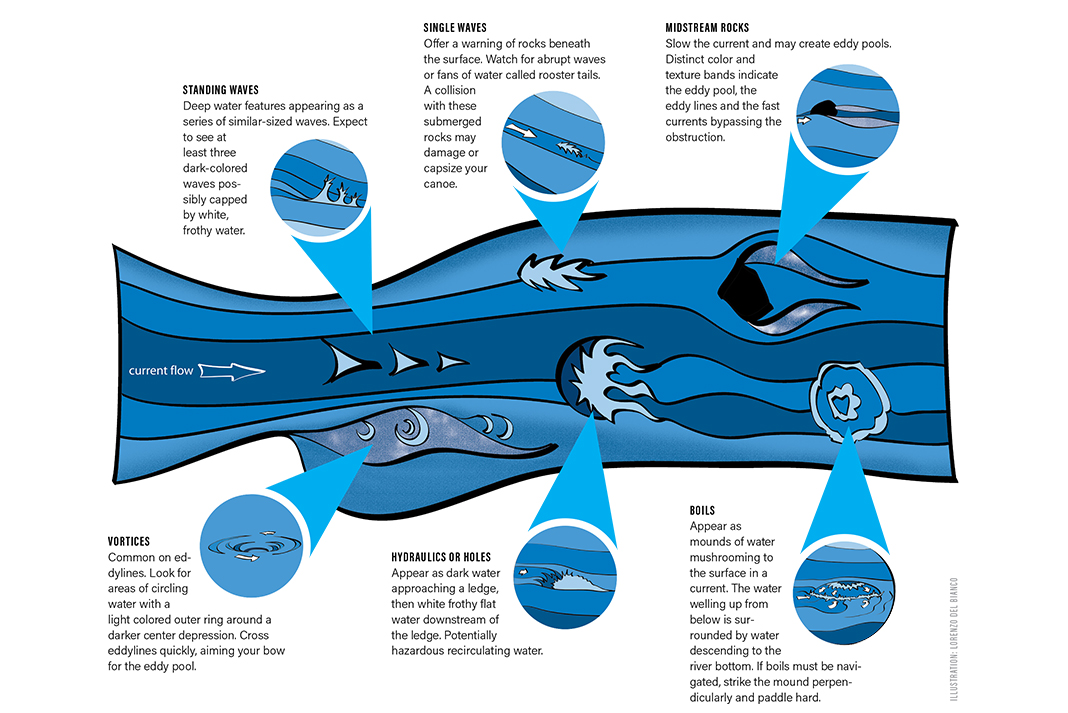
 Standing waves
Standing waves
Deep water features appearing as a series of similar-sized waves. Expect to see at least three dark-colored waves possibly capped by white, frothy water.
 Single waves
Single waves
Offer a warning of rocks beneath the surface. Watch for abrupt waves or fans of water called rooster tails. A collision with these submerged rocks may damage or capsize your canoe.
 Midstream rocks
Midstream rocks
Slow the current and may create eddy pools. Distinct color and texture bands indicate the eddy pool, the eddy lines and the fast currents bypassing the obstruction.
 Vortices
Vortices
Common on eddylines. Look for areas of circling water with a light colored outer ring around a darker center depression. Cross eddylines quickly, aiming your bow for the eddy pool.
Hydraulics or holes
Appear as dark water approaching a ledge, then white frothy flat water downstream of the ledge. Potentially hazardous recirculating water.
 Boils
Boils
Appear as mounds of water mushrooming to the surface in a current. The water welling up from below is surrounded by water descending to the river bottom. If boils must be navigated, strike the mound perpendicularly and paddle hard.
This article originally appeared in Canoeroots and Family Camping’s Spring 2010 issue and also in Paddling Magazine Issue 65. Subscribe to Paddling Magazine’s print and digital editions here, or download the Paddling Magazine app and browse the digital archives here.
Learning how to read whitewater is similar to learning a language. The more you practice, the better you’ll be at deciphering its message. | Feature photo: Chewonki Semester School/Flickr


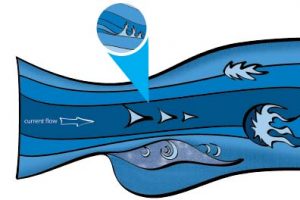 Standing waves
Standing waves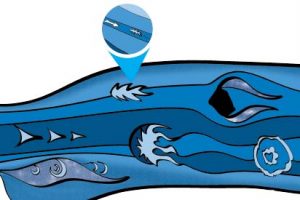 Single waves
Single waves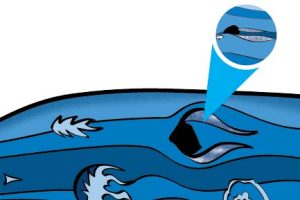 Midstream rocks
Midstream rocks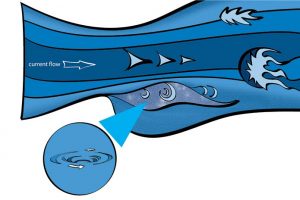 Vortices
Vortices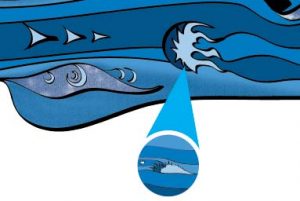
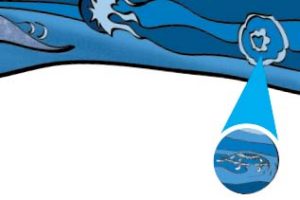 Boils
Boils